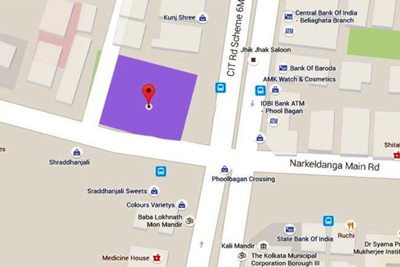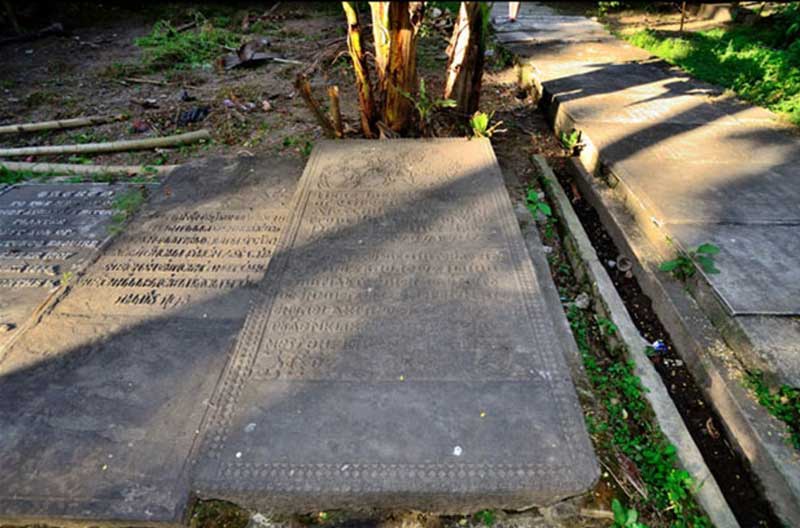
During the end of the Russo-Turkish War a sizable number of Greek families migrated to Calcutta in 1774, mainly from the rich commercial Thracian cities of Adrianoupolis and Philippoupolis. After that, they also arrived on the ships which carried the British colonialists from the Ionian Islands, as well as from the Greek cities in Cappadocia and the Aegean Islands.
At the beginning, like most of the other European communities, they flocked together in the vicinity of Lalbazar-Kolutola area and built a modest church in 1752. The second Greek Orthodox Church came up in Amratollah area, in north Calcutta, during the tenure of Warren Hastings. The necessary fund was raised for the construction of the building, but the bulk portion was contributed by Panagiotes Alexios Argyree, a prominent Greek merchant of Calcutta. It opened its door on 6th August 1781 and almost at the same time a cemetery for the Greeks was also opened in north Calcutta.


Gradually the Greek community in Calcutta started to get involved in various businesses, like trading of textile, salt, jute and accordingly, with the passing of the time, their population also started to increase rapidly. This resulted in shortage of space in the cemetery and soon a large plot of two acres was acquired in the eastern part of the city to set up a new Greek cemetery. This new cemetery, located at the crossing of Maulana Abul Kalam Azad Sarani and C.I.T road in Phoolbagan area, started functioning in 1777 and for the last time, a lady was buried there, in 2003.


There was a time, when the cemetery was guarded by iron fencing, now it has gone. Today the cemetery is under the grip of illegal encroachment and the boundary wall is almost in a crumbling condition. During monsoon, rain water blocks a large part of the yard and many marble slabs remain submerged under water for weeks together. The whole place is full of overgrown shrubs, weeds and bushes. Despite that, if somebody ventures to explore, he may find about 120 graves, out of which, named gravestones are 108 and remaining 12 are unnamed and unknown. Most of the tombstones are written in Greek. Use of English is significantly less. Few sculptures in the cemetery still survive and few of the tombstones still have a marble cross over them. There is an impressive sculpture on one particular, the sculpture of a young girl looking up with pensive eyes holding a cross.

The oldest grave here is of a man named Panagiotes Alexandros Argyres, a prominent Greek merchant of Calcutta. Born in Philippopolis in around 1710, Alexandros Argyree came to India in 1750. In 1771, he was sent to Cairo by Warren Hastings on a diplomatic mission to obtain permission for British merchants to trade in Egypt. On the successful accomplishment of the mission, he was given permission by Hastings to build a Greek Church in Amratollah Street in Calcutta. He eventually shifted his commercial operations to Dhaka where he died in 1777. Later, his body was buried here on August 7, 1777. The script is written in the memoir, ‘Here lies the body of the Greek merchant Alexandros Argreery from Philipopoly, who departed from this world on 5th August 1777’. During his burial, few other old tombstones were transported from the old cemetery of Amratollah to this place.

There is a small chapel inside the cemetery. The walls of the chapel are crowded with stone tablets inscribed in Greek. It mentions a priest named Mavroudis Kyriakou, who died on December 10, 1973 and buried in the cemetery.
Today, surrounded by the residential apartments and tucked behind the Metro Railway construction site at Phoolbagan, the Greek cemetery situated in 105, Maulana Abul Kalam Azad Sarani, is difficult to locate. Sadly enough, this significant graveyard, the only surviving Greek cemetery in Asia, now presents a gloomy and desolate picture. The dilapidated and vandalised cemetery contains a bleak chapter of history, which needs to be revived. The neglected area is now full of wild grasses and bushes. Even, a well has been dug right inside the premises, where the locals take bath and wash their utensils. It is a pity that, till now there is no initiative to protect and preserve this Greek cemetery, which is under the graded heritage list of Kolkata Municipal Corporation. However, it is said that, after the completion of the construction project at the site, the Metro Rail authorities will do something to renovate the place.
